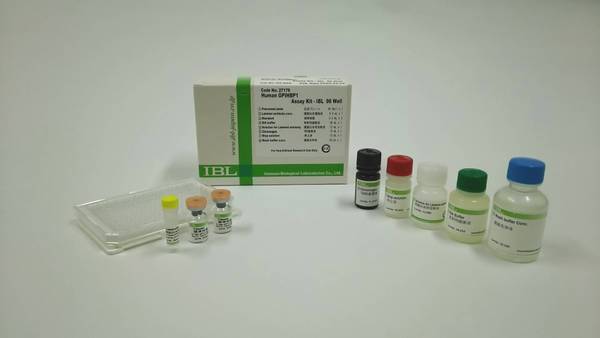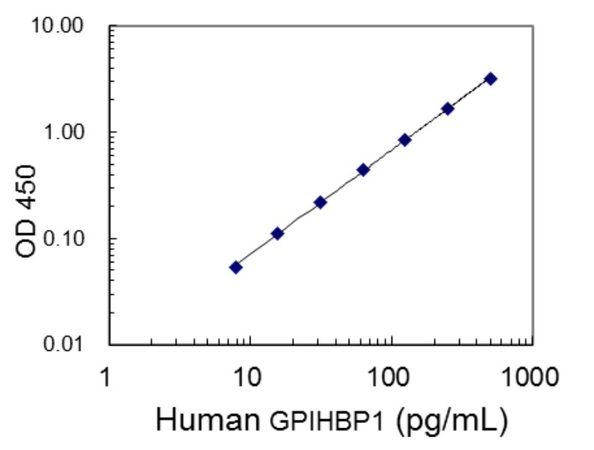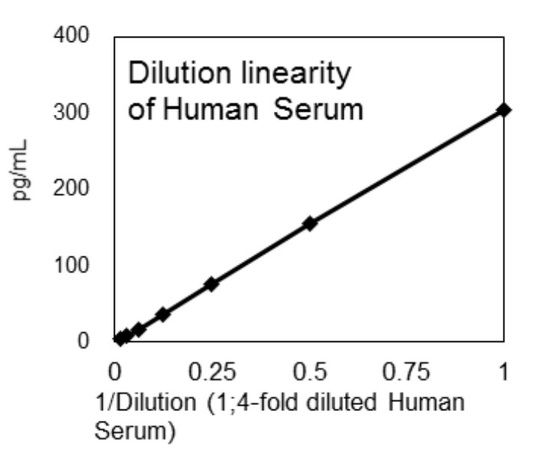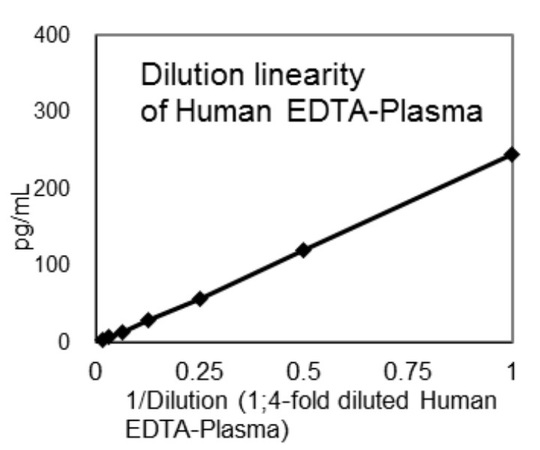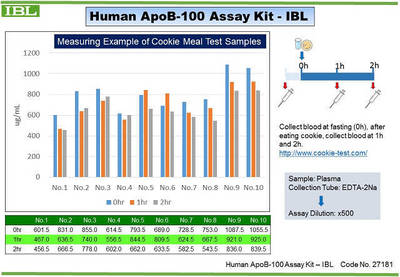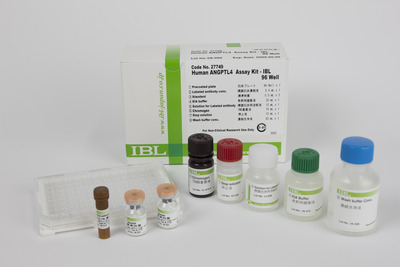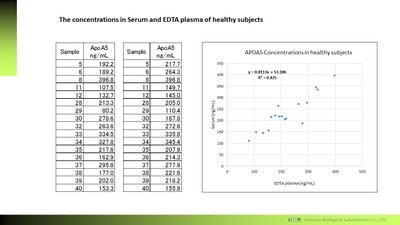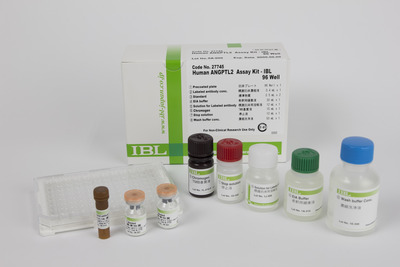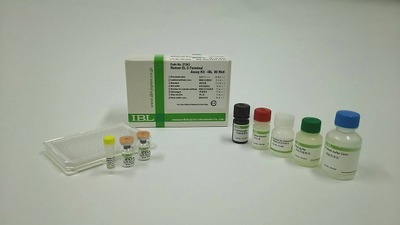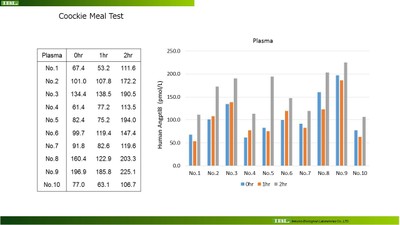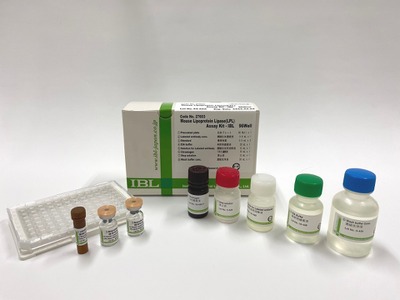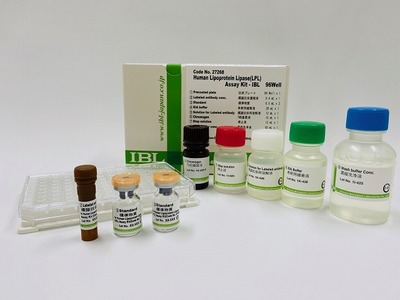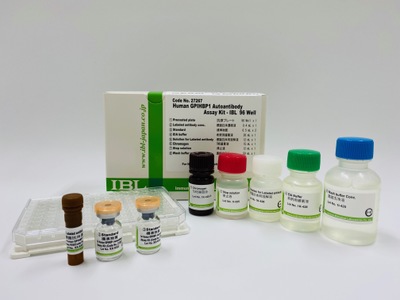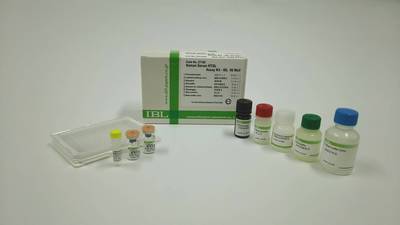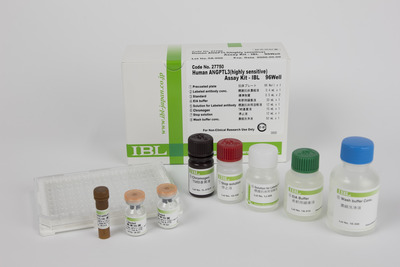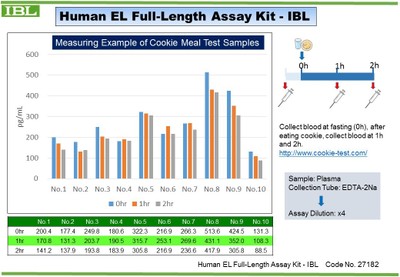- HOME >
- For Researchers >
- Product Search >
- Search Result >
- #27179 Human GPIHBP1 Assay Kit - IBL
Product Search
#27179 Human GPIHBP1 Assay Kit - IBL
- Intended Use:
- Research reagents
- Measuring Method:
- ELISA
- Sample Types:
- Human
- Measuring Samples:
- Serum, EDTA-plasma
- Measurement Range:
- 7.8 - 500 pg/mL
- Package Size1:
- 96 Well
※ The product indicated as "Research reagents" in the column Intended Use cannot be used
for diagnostic nor any medical purpose.
※ The datasheet listed on this page is sample only. Please refer to the datasheet
enclosed in the product purchased before use.
Product Overview
Product Overview
| Product Code | 27179 |
|---|---|
| Product Name | Human GPIHBP1 Assay Kit - IBL |
| Maker Name | Immuno-Biological Laboratories Co., Ltd. |
| Intended Use | Research reagents |
| Measuring Method | ELISA |
| Conjugate | HRP |
| Species | Human |
| Measuring Samples | Serum, EDTA-plasma |
| Measurement Range | 7.8 - 500 pg/mL |
| Primary Reaction | 60 minutes at 37 ℃ |
| Secondary Reaction | 30 minutes at 2 - 8 ℃ |
| Sensitivity | 0.99 pg/mL |
| Specificity | Specifically detect GPIHBP1 in human serum or EDTA-plasma. |
| Storage Condition | 2 - 8 ℃ |
| Poisonous and Deleterious Substances | Not Applicable |
| Cartagena | Not Applicable |
| Measuring Service | Not Available |
| Package Size 1 | 96 Well |
Product Description
Product Description
GPIHBP1 (Glycosylphosphatidylinositol anchored high density lipoprotein binding protein 1) is an anchor protein that is modified by glycolipid and it has been known that it exists on a capillary endothelial cell membrane and involves with metabolism of triglyceride rich (TG-rich) lipoprotein (triglyceride).
GPIHBP1 transports lipoprotein lipase (LPL) synthesized and secreted in adipocyte or skeletal muscle cells into capillary lumen by transcytosis and it binds LPL on the surface of endothelial cells so that GPIHBP1 has an critical role for metabolizing TG-rich lipoprotein.
This ELISA kit can measure GPIHBP1 in serum and plasma.
References (Not listed at PubMed)
A Woman With Hypertriglyceridemia Who Acquired Antibody Against GPIHBP1. Hirano et al. JACC: CASE REPORTS
Keywords:
Lipase / Lipid Metabolism / Dyslipidemia
GPIHBP1 transports lipoprotein lipase (LPL) synthesized and secreted in adipocyte or skeletal muscle cells into capillary lumen by transcytosis and it binds LPL on the surface of endothelial cells so that GPIHBP1 has an critical role for metabolizing TG-rich lipoprotein.
This ELISA kit can measure GPIHBP1 in serum and plasma.
References (Not listed at PubMed)
A Woman With Hypertriglyceridemia Who Acquired Antibody Against GPIHBP1. Hirano et al. JACC: CASE REPORTS
Keywords:
Lipase / Lipid Metabolism / Dyslipidemia
References
References
- A case of hyperchylomicronemia associated with GPIHBP1 autoantibodies and fluctuating thyroid autoimmune disease. Nozue T et al. J Clin Lipidol. 2022 Nov 4;S1933-2874(22)00294-X.PMID: 36402671
- Development of hypertriglyceridemia due to GPIHBP1 autoantibodies prior to clinical diagnosis of systemic lupus erythematosus in a 14-year-old girl. Kunitsu T et al. Allergol Int. 2022 Oct;71(4):555-557.PMID: 35662538
- GPIHBP1 autoantibody is an independent risk factor for the recurrence of hypertriglyceridemia-induced acute pancreatitis. Guofu Zhang et al. J Clin Lipidol. 2022 Sep-Oct;16(5):626-634.PMID: 36064883
- Circulating GPIHBP1 levels and microvascular complications in patients with type 2 diabetes: A cross-sectional study. Kurooka N et al. J Clin Lipidol. 2022 Mar-Apr;16(2):237-245.PMID: 35101360
- Anti-GPIHBP1 Antibody-Positive Autoimmune Hyperchylomicronemia and Immune Thrombocytopenia. Tanaka K et al. J Atheroscler Thromb. 2022 Feb 18.PMID: 35185060
- Association between ANGPTL3, 4, and 8 and lipid and glucose metabolism markers in patients with diabetes. Harada M et al. PLoS One. 2021 Jul 22;16(7):e0255147.PMID: 4293055
- Konjac Glucomannan Attenuated Triglyceride Metabolism during Rice Gruel Tolerance Test. Nagasawa T et al. Nutrients. 2021 Jun 25;13(7):2191.PMID: 34202167
- Changes in serum levels of angiopoietin-like protein-8 and glycosylphosphatidylinositol-anchored high-density lipoprotein binding protein 1 after ezetimibe therapy in patients with dyslipidemia. Ideishi A et al. Clin Chim Acta. 2020 Nov;510:675-680.PMID: 32858055
- Chylomicronemia from GPIHBP1 autoantibodies Kazuya Miyashita et al. J Lipid Res 2020 Sep 18;jlr.R120001116.PMID: 32948662
- Detailed analysis of lipolytic enzymes in a Japanese woman of familial lipoprotein lipase deficiency - Effects of pemafibrate treatment. Minamizuka T et al. Clin Chim Acta. 2020 Jul 17;510:216-219.PMID: 32682802
- GPIHBP1 autoantibody syndrome during interferon β1a treatment. Eguchi et al.J Clin Lipidol. 2019;13(1):62-69.PMID: 30514621
- Association between skeletal muscle mass and serum concentrations of lipoprotein lipase, GPIHBP1, and hepatic triglyceride lipase in young Japanese men. Matsumoto R et al. Lipids Health Dis. 2019 Apr 4;18(1):84.PMID: 30947712
- GPIHBP1 autoantibodies in a patient with unexplained chylomicronemia. Hu X et al. J Clin Lipidol. Jul-Aug 2017;11(4):964-971.PMID: 28666713
- Autoantibodies against GPIHBP1 as a Cause of Hypertriglyceridemia. Beigneux AP et al. N Engl J Med. 2017 Apr 27;376(17):1647-1658.PMID: 28402248
- An enzyme-linked immunosorbent assay for measuring GPIHBP1 levels in human plasma or serum. Miyashita K et al. J Clin Lipidol. 2018 Jan - Feb;12(1):203-210.e1.PMID: 29246728
Note: Retrieve by PMID number in displayed by abstract: http://www.ncbi.nlm.nih.gov
FAQ
FAQ
-
 Q.Is composition of EIA buffer of each ELISA kit all same? Can it be mixed to use?
Q.Is composition of EIA buffer of each ELISA kit all same? Can it be mixed to use?
ELISA common FAQ -
 A.No it isn't. As constitute of each EIA buffer is different, it cannot be mixed with other lots or EIA buffers contained in other kind of ELISA kits.
A.No it isn't. As constitute of each EIA buffer is different, it cannot be mixed with other lots or EIA buffers contained in other kind of ELISA kits. -
 Q.What is the composition of concentrated wash buffer?
Q.What is the composition of concentrated wash buffer?
ELISA common FAQ -
 A.It contains ordinary Tween and phosphate buffer (0.05% Tween-20 in PB).
A.It contains ordinary Tween and phosphate buffer (0.05% Tween-20 in PB). -
 Q.What is the feature of the plate?
Q.What is the feature of the plate?
ELISA common FAQ -
 A.We use plate that is flat bottom and removable strip type plate (8wellx 12 strips).
A.We use plate that is flat bottom and removable strip type plate (8wellx 12 strips). -
 Q.Can I re-use standard after reconstitution?
Q.Can I re-use standard after reconstitution?
ELISA common FAQ -
 A.Not recommended to re-use standard after reconstitution. Please use it at once after the reconstitution.
A.Not recommended to re-use standard after reconstitution. Please use it at once after the reconstitution.
Please note that there are some exceptions. One time freeze-thaw the standard is acceptable for use after reconstitution for some ELISAs.
Please check the details on each product datasheet. -
 Q.What is different between reagent blank and test sample blank?
Q.What is different between reagent blank and test sample blank?
ELISA common FAQ -
 A.Reagent blank means a well is only added EIA buffer and the purpose is confirming whether the Test sample value is influenced by lack of washing process or other operations. Test sample blank means a well is added EIA buffer and HRP antibody and the purpose is to calculate the background.
A.Reagent blank means a well is only added EIA buffer and the purpose is confirming whether the Test sample value is influenced by lack of washing process or other operations. Test sample blank means a well is added EIA buffer and HRP antibody and the purpose is to calculate the background. -
 Q.How many samples can be measured by this kit?
Q.How many samples can be measured by this kit?
ELISA common FAQ -
 A.The pre-coated plate contained in our ELISA kit is 96 wells plate. We recommend to use 16 wells (2 slits) for standard and 80 wells (10 slits) for 40 samples in duplicate.
A.The pre-coated plate contained in our ELISA kit is 96 wells plate. We recommend to use 16 wells (2 slits) for standard and 80 wells (10 slits) for 40 samples in duplicate. -
 Q.What is LOD (Limit of Detection)?
Q.What is LOD (Limit of Detection)?
ELISA common FAQ -
 A.It (LOD) is defined as sensitivity that is calculated using the NCCSL method. Please refer to a datasheet of each product.
A.It (LOD) is defined as sensitivity that is calculated using the NCCSL method. Please refer to a datasheet of each product. -
 Q.What is LOQ (Limit of Quantification)?
Q.What is LOQ (Limit of Quantification)?
ELISA common FAQ -
 A.It (LOQ) is the lowest value of measurement (standard) range. Please refer to a datasheet of each product.
A.It (LOQ) is the lowest value of measurement (standard) range. Please refer to a datasheet of each product. -
 Q.What is the definition of Over Night (O/N) reaction?
Q.What is the definition of Over Night (O/N) reaction?
ELISA common FAQ -
 A.It means that the reaction is required more than 16 hours unless otherwise specifically defined it on a datasheet of each ELISA product.
A.It means that the reaction is required more than 16 hours unless otherwise specifically defined it on a datasheet of each ELISA product. -
 Q.What is the specification of quality control for ELISA product release?
Q.What is the specification of quality control for ELISA product release?
ELISA common FAQ -
 A.The information of specification is available on individual lot specific CoA. Please contact us with your reference lot number for obtaining of specific CoA.
A.The information of specification is available on individual lot specific CoA. Please contact us with your reference lot number for obtaining of specific CoA. -
 Q.What is the number (e.g. 432143214321) at the edge of strips of the plate?
Q.What is the number (e.g. 432143214321) at the edge of strips of the plate?
ELISA common FAQ -
 A.According to the plate maker (ThermoFisher), it does not have any specific meaning as it is just the number of molds.
A.According to the plate maker (ThermoFisher), it does not have any specific meaning as it is just the number of molds. -
 Q.How to wash an ELISA plate?
Q.How to wash an ELISA plate?
ELISA common FAQ -
 A.Washing it by an auto-washer is highly recommended.
A.Washing it by an auto-washer is highly recommended.
If it is not available, please refer to the demo video (only 2 mins) using a washing bottle. -
 Q.The wells turned black during the test with the kit.
Q.The wells turned black during the test with the kit.
ELISA common FAQ -
 A.It is possible that the wells were not washed sufficiently during the washing process after the HRP-labeled antibody reaction.
A.It is possible that the wells were not washed sufficiently during the washing process after the HRP-labeled antibody reaction.
Be sure to wash the wells enough times as described in the data sheet with washing buffer of more than 350 µL.

